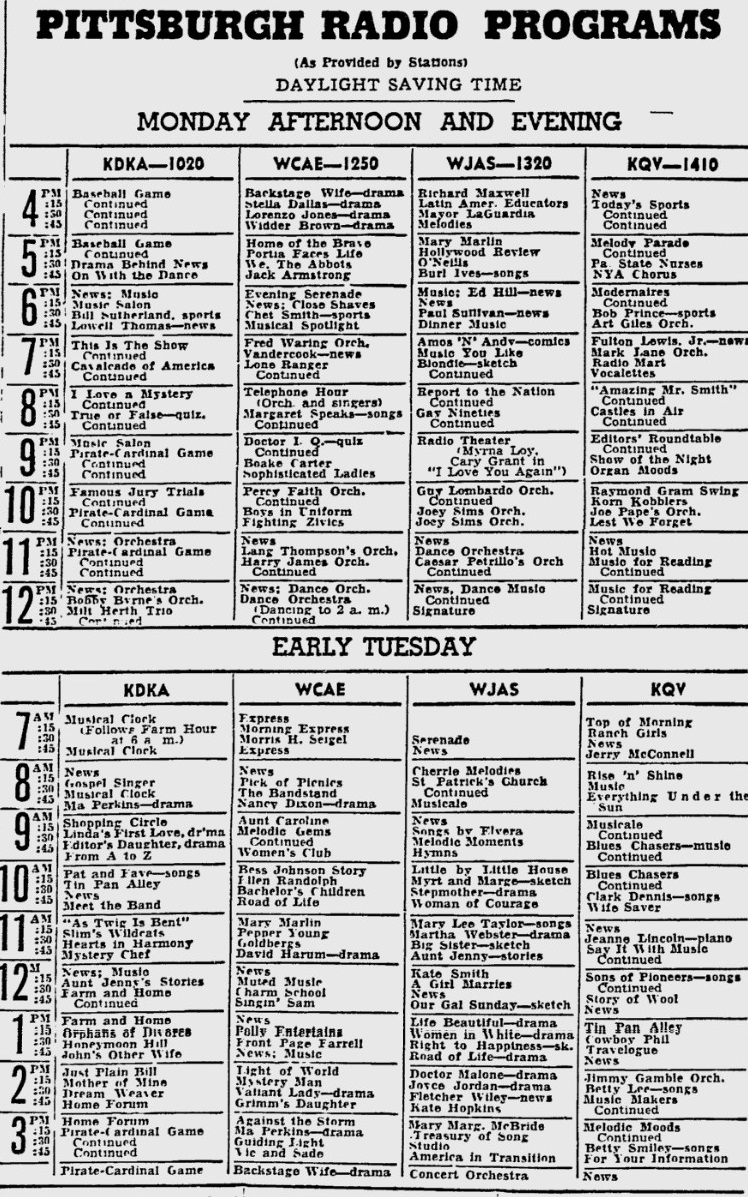 Here is what you would have heard on the radio 80 years ago today, June 30, 1941. This listing is from that day’s edition of the Pittsburgh Press.
Here is what you would have heard on the radio 80 years ago today, June 30, 1941. This listing is from that day’s edition of the Pittsburgh Press.

 Here is what you would have heard on the radio 80 years ago today, June 30, 1941. This listing is from that day’s edition of the Pittsburgh Press.
Here is what you would have heard on the radio 80 years ago today, June 30, 1941. This listing is from that day’s edition of the Pittsburgh Press.
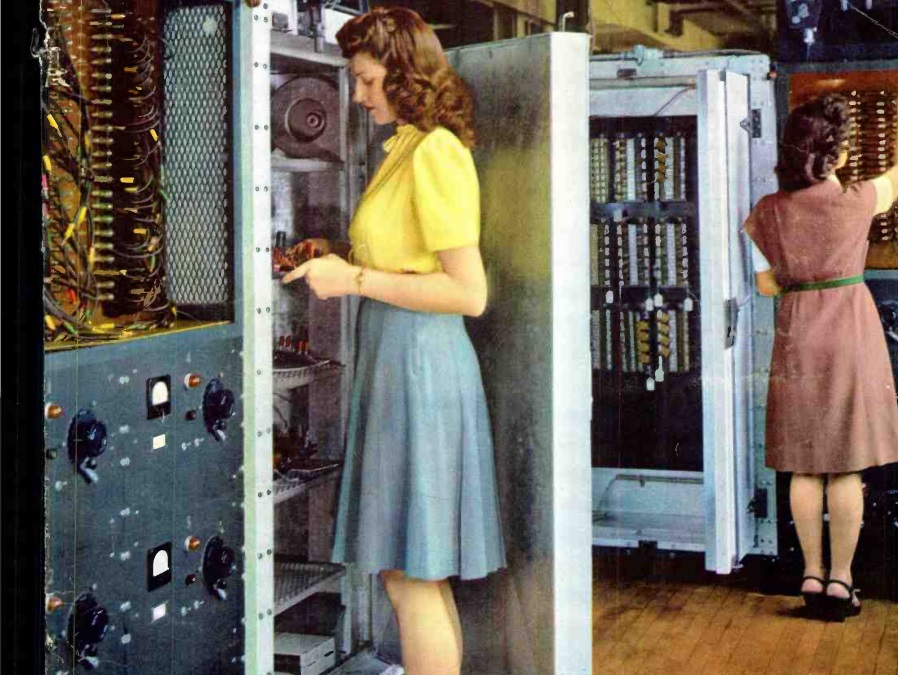 Seventy-five years ago, these workers are testing mica and paper capacitors from the assembly line of Sangamo Electric Company in Springfield, Illinois. Each day, samples were taken from the day’s production and subjected to life testing.
Seventy-five years ago, these workers are testing mica and paper capacitors from the assembly line of Sangamo Electric Company in Springfield, Illinois. Each day, samples were taken from the day’s production and subjected to life testing.
The photo appeared on the cover of Radio News, June 1946.
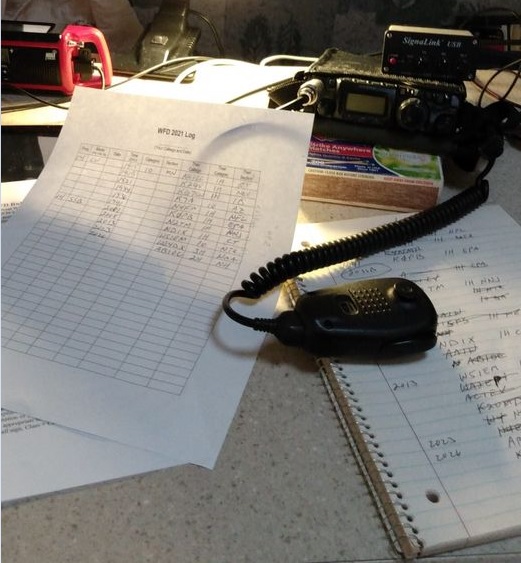 This weekend is ARRL Field Day, an amateur radio operating event in which hams set up their stations in remote locations and attempt to make as many contacts as possible. It’s a hotly debated question of whether it’s an emergency preparedness exercise, a contest, or just a fun weekend. The truth is that it’s all three.
This weekend is ARRL Field Day, an amateur radio operating event in which hams set up their stations in remote locations and attempt to make as many contacts as possible. It’s a hotly debated question of whether it’s an emergency preparedness exercise, a contest, or just a fun weekend. The truth is that it’s all three.
Even if all infrastructure were to be destroyed immediately, it would still be quite possible for hams to communicate worldwide using simple equipment, relying on nothing other than the laws of physics. Short of a zombie apocalypse, the need for such ability might be rare, but it’s a point of pride with hams what they can do.
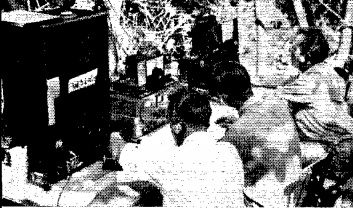
1946 Field Day. QST for Feb. 1947.
Amateur radio was off the air for the duration of World War II, so Field Day 1946, 75 years ago, was the first postwar opportunity for hams to show that they could still communicate off-grid.
When the results were published, it was pointed out that comparisons with earlier Field Days were not appropriate. Hams had only recently come back on the air, and they were not yet allowed on all bands. In particular, they did not yet have privileges on the 160, 40, and 20 meter bands, all workhorses of earlier Field Days. Instead, their HF was limited to 80, 11 and 10 meters. The top portion of the 80 meter band had just been re-opened, and here were the allocations, as shown in the June 1946 issue of QST:
The top score in the 1946 event was W2FC/2, the Jersey Shore Amateur Radio Association, which netted 9621 points from a total of 809 contacts. The 27 participants had eight transmitters on the air simultaneously.
Shown above is my most recent field operation. It wasn’t ARRL Field Day, but instead Winter Field Day 2021.
 A hundred years ago, these summer tourists were enjoying dance music at some fine hotel, thanks to the entrepreneurial spirit of a young radio enthusiast. This was but one idea shown in an article in the June, 1921, issue of Radio News.
A hundred years ago, these summer tourists were enjoying dance music at some fine hotel, thanks to the entrepreneurial spirit of a young radio enthusiast. This was but one idea shown in an article in the June, 1921, issue of Radio News.
The article started by noting that some young men might be trying to decide whether they should spend their money on a new piece of radio gear, or instead on a nice summer vacation. The solution to the dilemma was to parlay the radio hobby into a free vacation. Stamps were cheap, and it was simply a matter of proposing ideas to resort hotels: In exchange for free room and board, the entrepreneur could provide useful services to the hotel.
One such idea is illustrated above. A dance required music, and that music could come over the radio. In addition to being a source of the dance music, the radio was still a novelty in its own right, and would have a particular allure.
Some hotels might be in remote areas, and the morning papers might not arrive until the afternoon. A young man equipped with a radio set could get the morning headlines to guests before the papers arrived. And the presence of the two-way set could be an important selling feature for a hotel to offer the availability of emergency message sending.
In some cases, the young man could offer radio classes to guests. Also, a young man with a radio set would have numerous networking opportunities. The possibilities were endless!
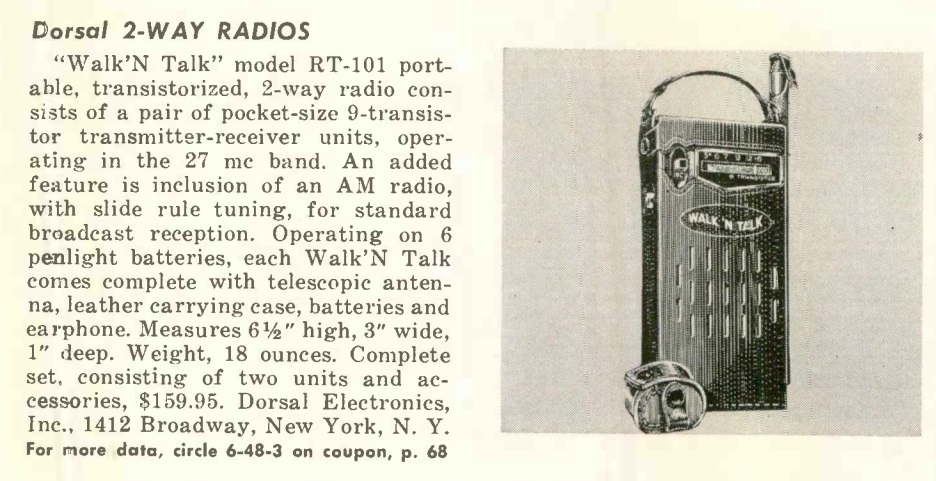 Sixty years ago this month, the June 1961 issue of Electronics Technician magazine showed this interesting combination, a two-way radio for 27 MHz, with a built-in AM radio.
Sixty years ago this month, the June 1961 issue of Electronics Technician magazine showed this interesting combination, a two-way radio for 27 MHz, with a built-in AM radio.
The “Walk’N Talk” model RT-101 is being advertised to radio and electronics technicians, and it might come in handy for tasks such as aiming a TV antenna. It’s probably a 100 mW unit, so no license was required. The built-in AM radio seems like a nice touch. A set of two retailed for $159.95. According to this inflation calculator, that works out to over $1400 in 2021 dollars, so it’s apparently for the well heeled electronics technician. I don’t know if it’s still available, but you can see a nicely preserved example at this Facebook Marketplace listing.
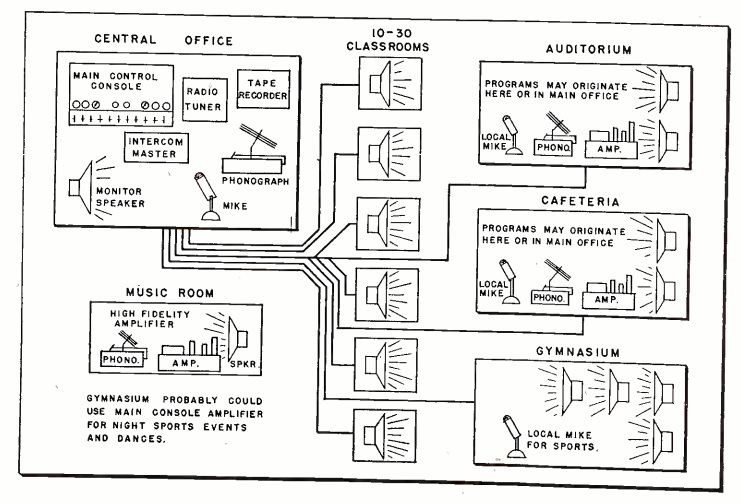 Seventy-five years ago this month, the June 1946 issue of Radio Retailing reminded dealers of the profits to be made selling public address systems to schools. It detailed the experience of a dealer in North Carolina. The school district had just experienced growth, and there was a need for new facilities. And in a progressive district, new buildings meant the latest in technology.
Seventy-five years ago this month, the June 1946 issue of Radio Retailing reminded dealers of the profits to be made selling public address systems to schools. It detailed the experience of a dealer in North Carolina. The school district had just experienced growth, and there was a need for new facilities. And in a progressive district, new buildings meant the latest in technology.
And the local radio dealer was ideally poised to serve as expert in all matters involving sound. This dealer was consulted at two school board meetings, and walked away with the contract for the installation.
“Get out your paper and pencil today and start figuring your profits for tomorrow’s PA sales to your local institutions. They’re waiting for you!”
 110 years ago, a young John Long of Leechburg, PA, sent in this self-explanatory idea for building an alarm clock to the “Young Edisons” department of Popular Electricity magazine.
110 years ago, a young John Long of Leechburg, PA, sent in this self-explanatory idea for building an alarm clock to the “Young Edisons” department of Popular Electricity magazine.
The magazine carried the feature of letters from readers of its Junior Department. Letters were to accurately and briefly describe experiences in the making and operation of electrical devices and the performance of electrical experiments. The magazine asked readers, “see how good an ‘engineering report’ you can make of your investigations.”
Young Mr. Long constructed this alarm switch with a battery, door bell, and pocket watch.
Some links on this site are affiliate links, meaning this site earns a small commission if you make a purchase after clicking on the link.
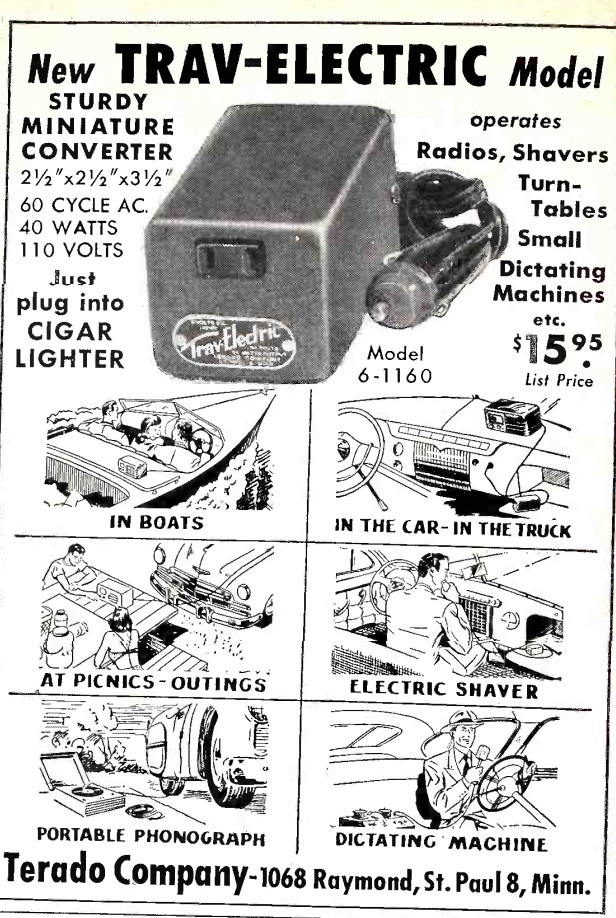 I found this ad from 75 years ago to be intriguing. It’s an inverter for running 120 volt appliances from a car’s electrical system, presumably six volts. The ad appeared in the June 1946 issue of Radio Retailing.
I found this ad from 75 years ago to be intriguing. It’s an inverter for running 120 volt appliances from a car’s electrical system, presumably six volts. The ad appeared in the June 1946 issue of Radio Retailing.
I haven’t found much information about this unit, model 6-1160, But it’s almost certainly vibrator driven. The electromechanical vibrator changes the DC to a square wave, which is stepped up by a transformer. It’s billed as providing up to 40 watts.
It’s priced at $15.95. According to this inflation calculator, that works out to about $330 in 2021 dollars. By comparison, a modern one such as the one shown here outperforms it and sells for just a few dollars.
The manufacturer, the Terado Company, appears to be defunct, but their street address jumped out at me. I drive past it, 1068 Raymond Avenue, St. Paul, MN, almost every day. There is currently an apartment building at that address, which I believe was built in the 1980s.
Some links on this site are affiliate links, meaning this site earns a small commission if you make a purchase after clicking on the link.
Today, I complete the Ration Challenge. For the past seven days, my diet consisted of the same rations provided to Syrian Refugees in Jordan. This is a fundraiser for Church World Service. You can make your donation at this link:
I did get a bit of variety, such as a can of sardines, a couple of eggs, and a potato. But for the most part, my “staff of life” was rice, chickpeas (garbanzo beans), and lentils. For the week, I had about three pounds of rice, 3 ounces of dried chickpeas, and 6 ounces of lentils. Each day, at least one of my meals consisted of a soup with these ingredients, flavored with chicken bouillon. I also had three cups of flour (which I turned into the flatbread shown above), but most of my carbohydrate needs came from the rice.
My soup was satisfactory, but many other participants were able to come up with much more creative recipes for the ingredients. You can see many of them in their Facebook group.
One of the focuses of this website is emergency preparedness, and it didn’t escape my notice that these ingredients would form an inexpensive base for emergency food storage. They do require cooking, but they are inexpensive and have a practically indefinite storage life. These ingredients fed me relatively well for seven days. For one year, I would need the following quantities:
At today’s normal supermarket prices, these ingredients would cost about $125. And chances are, by shopping around and buying larger packages, the cost would be even lower. (Even though I didn’t add it to my soup recipes, one of my major sources of calories this week was the 12 ounces of cooking oil. That works out to about five gallons per year, which would add approximately $30 at typical supermarket prices.) One would not eat well if these were the only things you had to eat, but this relatively small expense would guarantee that one person would have minimal nutrition for a full year. It seems like a cheap insurance policy.
For those of us in places like North America and Europe, it seems inconceivable that we might become “refugees” and have to worry about finding enough food to eat. But I suspect that most of the Syrian refugees in camps in Jordan didn’t think so either. Most of them were probably living middle-class lifestyles at some point. They weren’t always refugees, just as you and I are not refugees today.
If we take a little bit of time to plan ahead for emergencies, we can help ourselves at the time of some future disaster. But more importantly, we can be in a position to help our friends and neighbors.
And if you are able, please make a donation to help today’s refugees through Church World Service at this link:
Some links on this site are affiliate links, meaning this site earns a small commission if you make a purchase after clicking on the link.
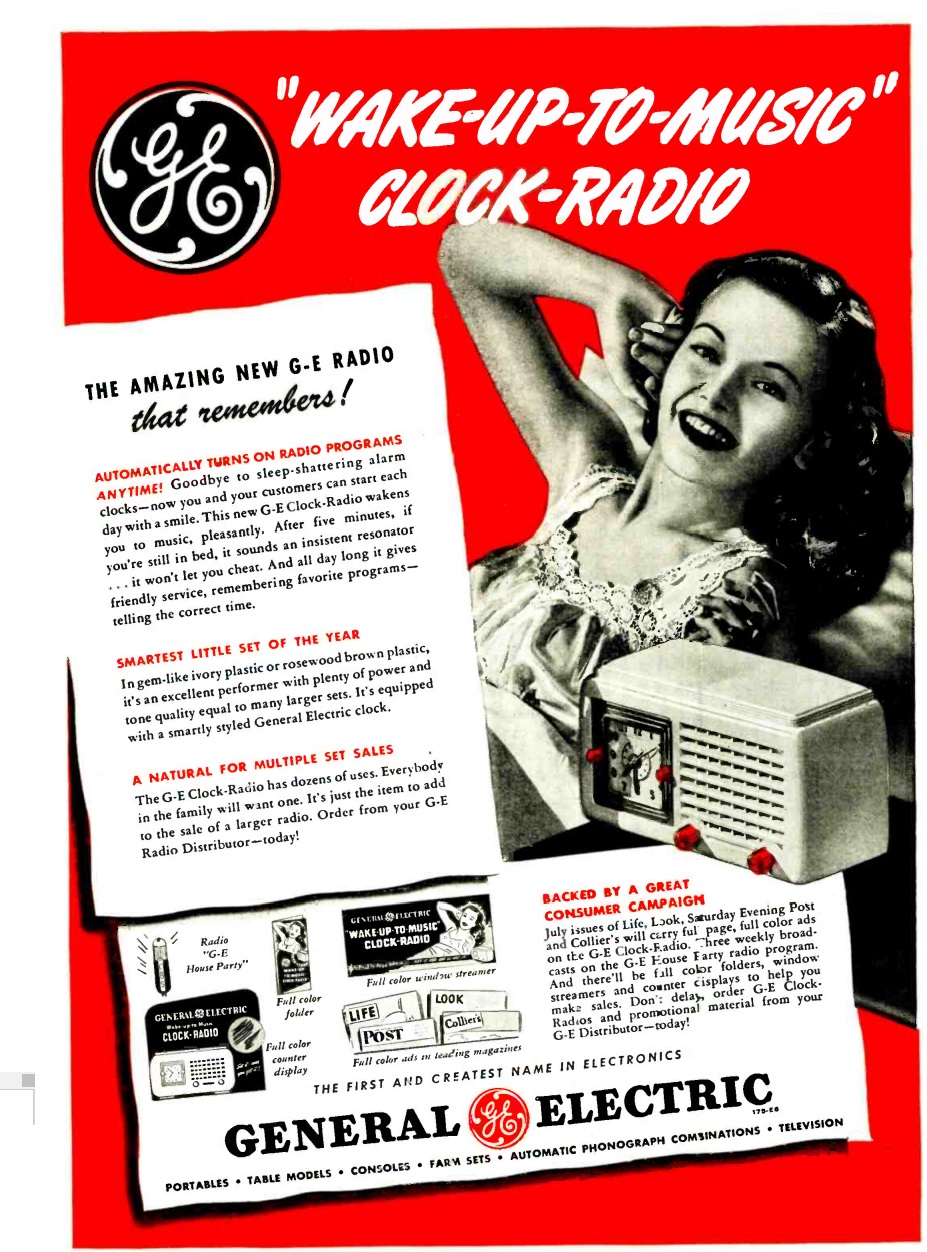 The postwar era brought a new product: The clock radio. This ad, from the June 1946 issue of Radio Retailing, showed one of the earliest examples from General Electric, which appears to be a model 50, a four-tube set.
The postwar era brought a new product: The clock radio. This ad, from the June 1946 issue of Radio Retailing, showed one of the earliest examples from General Electric, which appears to be a model 50, a four-tube set.
With this new innovation, customers could say goodbye to sleep-shattering alarms, but after five minutes, an alarm would sound, to keep them from cheating. Dealers were encouraged to stock up, since it was a natural for multiple set sales. Everyone in the family would want one, and there was a great ad campaign in progress, along with full color point of sale displays.